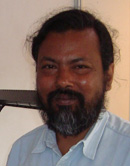
My experience with Bookeye® - Customer Tells It Like It Is
3. February 2010
From Abhijit Bhattacharya, Centre for Studies in Social Sciences, Calcutta

In the month of January 2009 I had to propose discontinuing microfilming and switching for best possible scanning solution for the Urban History Documentation Archive of the Centre for Studies in Social Sciences, Calcutta during a meeting of the academic committee for the archives. It was not that, I have considered microfilming as a redundant technology, but over last five years several problems started popping up with microfilming. Though still I believe microfilm is the most dependable backbone for an archive following paper documents, whereas, digital backbone is still little uncertain in terms of durability and dependability, but with problem of supply of raw stock, poor quality of digital output from microfilms combined with several other technical and administrative factors forced me to take such a decision that has been backed by several leading archivists from different parts of world with assurance of security by multiplying digital documents and storing them in different medium. However, my proposal has been approved by the committee and I started looking for vendors for the service and all vendors with different makes of overhead scanners produced frustrating result that forced me to take a rather desperate decision to buy a scanner for the institute, though that was an expensive proposition for a small research institute depending on Government of India grant where the archive, as a department is a recent entity.
Then the crucial question came in mind, which make and model? As it is really difficult to choose one single instrument in the digital world which is smart, productive and durable at the same time, and a small archive with a shoestring budget cannot afford experimenting with multiple scanners. So I send a SOS to my archivist colleagues in different parts of world. After one day or two, I have received an answer from my colleague G. Sundar, Director of RMRL, Chennai, one of the best archives of South Asia; the answer was a one-liner (as he was not so happy with my idea of switching from microfilming to digitization) “Then go for the best: www.bookeye.com” and that’s all. Once query submitted I have received response from Bookeye® main office with an advice to contact Mr. Manish Chhabra of Vikman’s and the process began.
In June 2009 I have had my first meeting with Mr. Chhabra in his small office at Nehru Place, New Delhi, and I found someone not so hard selling ANY product to satisfy the customer, on other end we have our own budgetary constraints. But I have also noticed Mr. Chhabra’s passion for archive so I started, with some hesitations, working with Mr. Chhabra’s recommendations; while comparing his arguments in favour of hardware and software of Bookeye® from my colleagues attached with digital archives and from available literature. Readers of the personal testimonial can easily understand dilemma of shifting technology and conventional process. However, the official order placed, instrument supplied and installed and the robust machine integrated with its intelligent software is now engaged for retrieving 19th century newspapers available in paper-pulp state for last four months and capturing glimpses of history of nationalist movement and colonial governance in Bengal presidency for historians of future.
During my meeting with Mr. Chhabra in June 2009 I expressed my worries about pricing and reliability of the instrument, then Mr. Chhabra said that “with that price we will give you world’s leading scanner and take your headache”, I was skeptical, but when installed and some teething problem popped up with scanner configuration but mostly with our documents. While choosing, we opted for Bookeye® 2plus GS scanner, overlooking the fact that the newspapers till 1960s being published in a non-standard format and pages are considerably larger than A2 format of present days. Mr. Chhabra assured over phone that solution of that problem would not be a problem and after a couple of weeks Mr. Chhabra, his business partner Ms. Kaur and Sumit, IT head of Vikman’s came to Calcutta, Sumit fixed all software related problem and fixed the scanner head in a way that the scanner could accommodate more pixels and much wider area. So now the A2 scanner keeps capturing oversized A2 papers. Also, whenever we encounter any problem the solution is just one phone call away. So far whatever problem our technical department encountered, Sumit resolved everything with his remote connection tool. Now after four months of installation, I know, Vikman’s is the one stop solution for all imaging solutions for digital archives.
Bookeye® is not flawless, especially the 2plus model, it is a very good stationary scanner, but lacks portability which is much required for our job. As since 1993 the CSSSC is primarily engaged in retrieving archival documents from old archives in Calcutta city, smaller towns and villages in the districts of West Bengal and Assam. For the task, the CSSSC team move with instruments to such remote locations, as our policy is not to take the original archive out of its own location, rather retrieve a copy of the archive. But with about 25 kilograms of weight and a huge dimension, moving with the scanner to places is not possible, especially, while we have to work in remote areas and in buildings, mostly constructed in 19th century with multiple later unplanned additions. Well, Bookeye® 3 is a solution, but price is quite steep for most of the social science research institutions and only a few well funded national level libraries and archives can afford to install such expensive instruments.
Well, I can easily understand, compared to the output of the instrument that price is logical, but Bookeye® can consider a different pricing strategy for developing countries, as billions of pages of rich heritages are yet to be retrieved for historians of present and future.